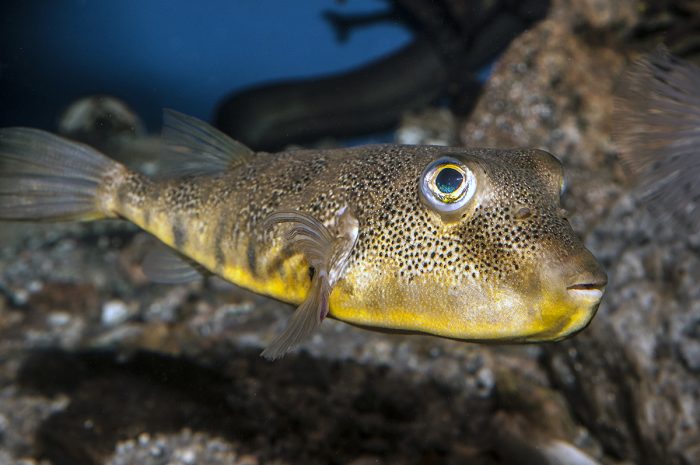
They swell up, they blow up, they puff up. Their unusual defense against predators makes this blowfish a hoot.
Northern puffers are found on the Atlantic coast of North America from Newfoundland to Flagler County, Florida, over sand bottom near or in and around seagrass in waters ranging from 3 to more than 600 feet deep.
It is the only pufferfish that is abundant along the mid-Atlantic coast. This species uses its strong, beak-like mouth to crush the shells of small mollusks, crustaceans and other invertebrates. I have seen small puffers swimming in the surf zone, near breaking waves, feeding on small animals churned up by the wave action.
In North Carolina waters, the northern puffer is a small to medium-sized fish with a blunt body capable of inflating with water and air. Puffers have grayish-brown backs and upper sides, but are yellowish white on the lower sides and belly. Tiny black spots are scattered over most of the body, particularly near the cheeks, and there is a row of seven to 10 vertical bars along the sides. The head and body are covered with prickles that give the skin a sandpaper-like quality, according to the North Carolina Division of Marine Fisheries website.
It’s easy to distinguish a northern puffer from its close cousin, the striped burrfish, which is also a frequent visitor to North Carolina coastal waters. First, the puffer is club shaped whereas the burrfish is boxier in shape. Second, the northern puffer has no noticeable spines along its body, while the striped burrfish has large, prominent spines all along the full length of its body. The puffer is small and olive colored, with numerous tiny black spots along its body, while the burrfish lacks the tiny spots.
“The Northern puffer is found in bays and estuaries, as well as offshore waters to depths of at least 180 feet,” Jason Rock, biologist supervisor with the North Carolina Division of Marine Fisheries, told Coastal Review. “This species is not a schooling species, but has been observed by scuba divers in large, disorganized congregations on the sand bottom. They will feed on mainly shellfish, but will occasionally eat small finfish. The numbers of fish that are caught throughout their range are negligible, but catches are higher further north in New England waters, they are typically caught using crab pots and with hook-and-line. In supermarkets, the puffer is typically sold as fresh Sea squab.”
Between 1962 and 1970, the annual landings from the Chesapeake Bay region alone were between 1 and 12 million pounds. During this period, commercial landings increased as the fish moved their way north during spring from North Carolina to the Chesapeake Bay. During fall, the catch generally moved southward. This gave fisheries scientists a sense that the northern puffer made an annual migration along the coast, but little is known about its life history.
“In North Carolina, from 2010 to 2019, landings averaged around 4,000 pounds. I looked at some recreational landings and they were a little higher and averaged around 30,000 pounds a year from 2000 to 2009. Landings coastwide now are pretty low for both recreational and commercial fisheries,” Rock said.
“This species is also called swell toad, puffer, blowfish, blow toad, toadfish, and sea squab. They are occasionally confused with oyster toadfish, porcupine fish, and striped burrfish, depending upon where in its’ range you find the species,” said Rock.
Northern puffers are usually seen in North Carolina waters ranging from 8 to 10 inches in length, but have been observed up to 14 inches in length and 1½ pounds. No awards are provided for catching northern puffers.
Chris Batsavage, special assistant to councils with the North Carolina Division of Marine Fisheries, told Coastal Review that the northern puffer is not currently managed by the state, the South Atlantic Marine Management Council nor the Atlantic States Marine Fisheries Commission.
“Pufferfish spawn in the shoal waters close to the shore, from mid-May, in Chesapeake Bay, and from early June through the end of the summer off southern Massachusetts. They are prolific spawners. The ovaries of a Chesapeake Bay female that was 10.5 inches in length had about 176,000 eggs. These eggs are about 1/32 of an inch in diameter, with many small oil globules, that sink and stick quickly to each other, or to whatever they happen to contact on the bottom. Eggs will hatch between three and a half to five days later, depending upon water temperatures in the 67-68 degree Fahrenheit,” Rock said.
According to Henry B. Bigelow and William C. Schroeder’s book, “Fishes of The Gulf of Maine,” first published in 1953, northern puffer larvae are about 3/32 of an inch in length when hatched and are brilliantly colored with orange, red, yellow and black. Within three days, the mouth will form, when they are about 9/32 of an inch in length. At this stage they start to resemble tiny mature northern puffers. Even at this tender age, they can inflate themselves when threatened.
The fish has four powerful teeth that are used to crush practically any food source they can find including, mussels, clams, crabs, worms, shrimp, sea plants, sea urchins and sea squirts, said Rock.
The northern puffer, unlike species of puffers found elsewhere, is not harmful to eat — it has long been consumed by people. But some scientists believe there may be low-level toxins in the organs and skin of the fish.
“If you want to eat any puffers in North Carolina that you may catch, it is a good idea to remove all of skin and viscera before eating them,” Rock said.
Puffers inflate by placing water or air into a special chamber near their stomachs. A northern puffer that is caught and released while inflated will briefly float upside down at the surface before quickly losing the volume from and swimming away. And they’re not particularly good swimmers. A northern puffer moves forward in the water column by waving its caudal, or tail, fin back and forth like that of a ping pong paddle.
The best way to catch puffers is to use a hook and line near shore from jetties, piers, small boats and from coastal waters with a double-hook rig that is fished on the bottom and using bloodworms, shrimp or squid as bait.
“Females are significantly larger than males at each age. Most growth, in terms of length, occurs during the first growing season from June through October,” Rock said.
They become sexually mature between their first and second year of life. Peak spawning occurs in June and July.





